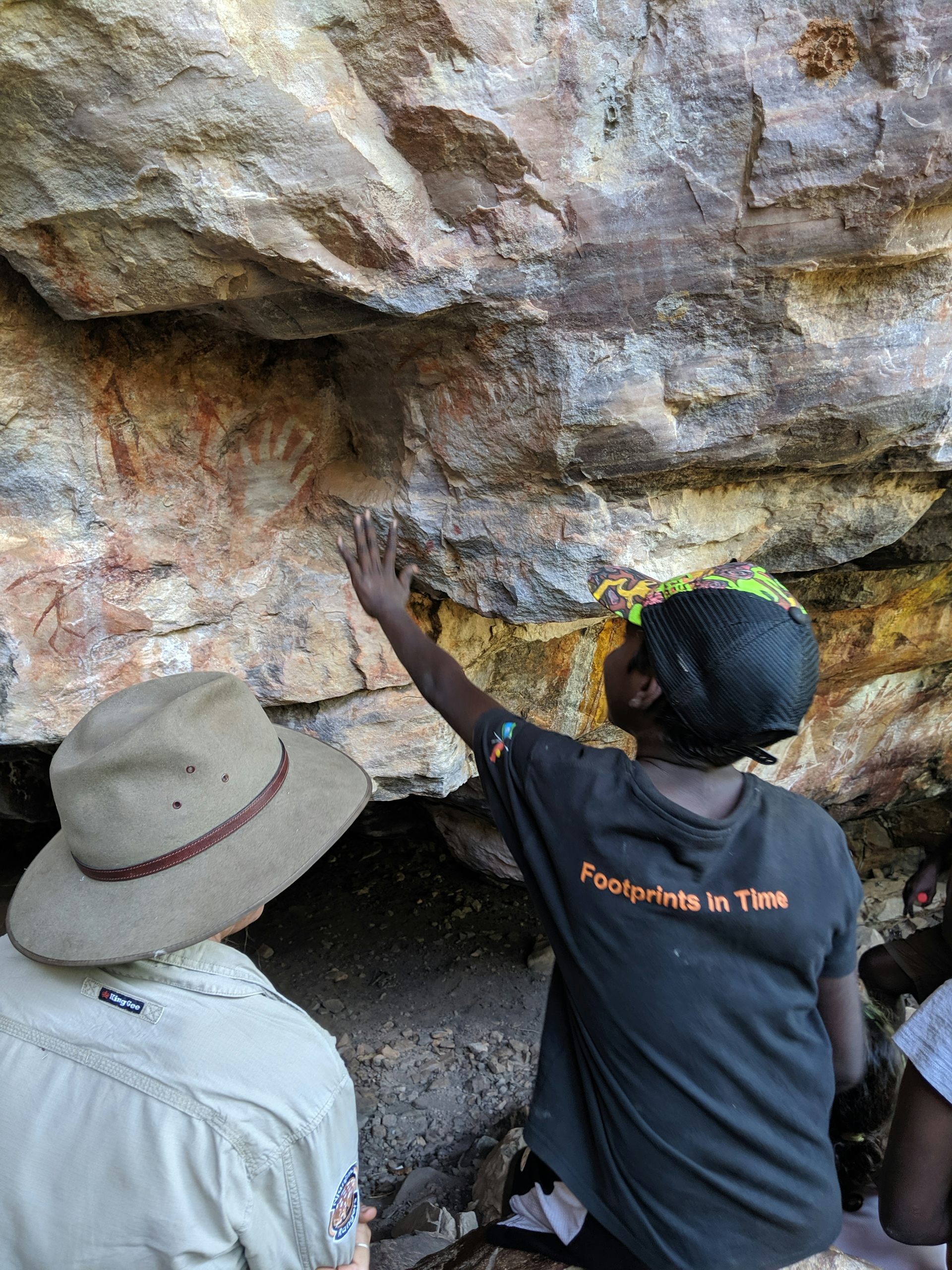New analysis unlocks the hidden meaning of 15,000-year-old rock art in Arnhem Land
What the authors of Genesis didn't know was that, not only is Earth a spheroid, but there are people living on the land masses on the far side of it; people moreover who had lived there for about 40,000 years and had been leaving a record in the form of drawings and paintings on rocks for about 10,000 years. Had they done so, they would have written about a spheroid earth that was at least 40,000 years old instead of a flat one that was only about 7,000 years old when they wrote about it being magicked out of nothing at the same time as the sun and stars.
One of my favourite quotes that, for some reason, theologians rarely talk about, is by the 'father of modern theology, St Augustine of Hippo (354-430 CE), who was canonized for his 'divinely-inspired' wisdom, on the 'controversy' of the shape of Earth:
But as to the fable that there are Antipodes, that is to say, men on the opposite side of the earth, where the sun rises when it sets to us, men who walk with their feet opposite ours that is on no ground credible. And, indeed, it is not affirmed that this has been learned by historical knowledge, but by scientific conjecture, on the ground that the earth is suspended within the concavity of the sky, and that it has as much room on the one side of it as on the other: hence they say that the part that is beneath must also be inhabited. But they do not remark that, although it be supposed or scientifically demonstrated that the world is of a round and spherical form, yet it does not follow that the other side of the earth is bare of water; nor even, though it be bare, does it immediately follow that it is peopled.
It is too absurd to say, that some men might have taken ship and traversed the whole wide ocean, and crossed from this side of the world to the other, and that thus even the inhabitants of that distant region are descended from that one first man. [My emphasis]
translated by Rev. Marcus Dods, D.D.; from the Christian Classics Ethereal Library at Calvin College.
But People got to the 'Antipodes' thousands of years even before Adam was supposedly magicked into existence, let alone when Noah lived. So, by St Augustin's logic either Earth is lot older than even he thought from reading his Bible, or there never was a 'first man'. Either way, it is clear that the 'Father of Modern Theology' was misled by the Bible, which has turned out to be neither history nor science!
It's mistakes like that that tell us not only was Genesis not written by an omniscience creator but that the authors were parochial and ignorant in the extreme. They thought two of each species of all known animals, who all lived a few days walk from Noah's house, could fit on a wooden boat, that a local flood covered the entire flat Earth and the magic man who made it all lived just about the dome over it all, straight up from where everyone lived.
Of course, we now know that, in the very long history of pre-'Creation Week' Earth, even the 15,000-year-old rock paintings are relatively recent.
Now a group of archaeologists and Aboriginal culture experts, Jarrad Daniel Kowlessar, Associate Lecturer, Flinders University, Alfred Nayinggul, Senior Erre Traditional Owner, Indigenous Knowledge, Daryl Wesley, Senior research fellow, Flinders University and Ian Moffat, Associate Professor of Archaeological Science, Flinders University, have discovered more information recorded in the rock art of Arnhem Land that the authors of Genesis could never have dreamed of.
They recorded changes in the environment due to climate change, sea-level changes, the transformation of river valleys and plains into coastal mangrove swamps, etc., and later the arrival of European colonists in sailing ships. The authors of Genesis never mentioned sea-level changes because they lived too far from the coast to even notice that the horizon was due to the curvature of a spheroid Earth, for example, so assumed it was all flat, like their small fragment of it, save only for a few low hills.
The authors of the paper in Archaeological and Anthropological Sciences also describe their work and its significance in an article in The Conversation: It is reproduced here under a Creative Commons license, reformatted for stylistic consistency:

Jarrad Daniel Kowlessar, Flinders University; Alfred Nayinggul, Indigenous Knowledge; Daryl Wesley, Flinders University, and Ian Moffat, Flinders University
Rock art is one of the most intriguing records of the human past – it directly represents how our ancestors viewed their world. This provides a fundamentally different perspective compared to other archaeological items, such as stone artefacts.
Despite this beguiling potential, rock art research can be highly challenging. Different researchers can have contrasting interpretations of what the same image means. Sometimes they can’t even agree on what the rock art represents.
Given these difficulties, how can rock art contribute to understanding the past?
Our new research published in Archaeological and Anthropological Sciences uses an innovative approach to understand rock art in Arnhem Land in a fundamentally different way.
A dramatic landscape change
Our work concerns the Red Lily Lagoon area. This part of western Arnhem Land contains an internationally significant record of humanity’s past, including Australia’s oldest archaeological site.
It has also been the subject of dramatic landscape change as a result of sea levels rising significantly over the last 14,000 years.
The coastline moved from hundreds of kilometres away to right up against the cliffs in the Red Lily region, before retreating northwards about 50km to its current position. These changes would have had profound implications for people living in the area.
The complex landscape of sandstone cliffs and flat floodplains would have dramatically changed: from open savanna, to mudflat, to mangrove swamp. Eventually it would become the seasonally inundated freshwater wetlands that exist in the region today.
An astonishing rock art record
Arnhem Land has an astonishing rock art record that continues to be maintained by Traditional Owners today.
The rock art in Arnhem Land can be categorised into a number of different styles, which change over millennia. These styles, including the well-known X-Ray style, are thought to align with landscape changes driven by sea level rise. For example, saltwater animals such as fish appear in the rock art record when the sea had risen enough to impact this area.
To overcome the subjective nature of interpreting the artwork, archaeologists often turn to the landscape – to understand the placements of different types of art.
This approach usually assumes that the landscape today looks similar to when the art was painted. In Arnhem Land, where rock art has been estimated to be over 15,000 years old and the landscape has changed dramatically over this time, this isn’t true.
Our research used high-resolution elevation data, created from plane and drone surveys, to understand the placement of rock art sites throughout the landscape. We also mapped buried landscapes using imaging techniques to understand how the landscape has changed over time.
We used this data to understand how much of the landscape could be seen from each rock art site during each period of landscape evolution. We also examined what type of landscape was visible from each location.
This is the first time this approach has been used in Arnhem Land. The results provide new insights into what inspired people to create rock art at different times in the past.
Valuable mangroves
Importantly, we found rock art production was most active, diverse in style, and covered the most area of the plateau during the period when mangroves completely covered the floodplains.
This may be because the mangroves provided abundant resources which sustained a large and stable human population. Or perhaps it was a response to the substantial contraction of available land caused by the sea level rise.
We also found that during the period when the sea level was rising, rock art was preferentially made in areas with long-distance views over areas of open woodland.
This may have been to facilitate hunting, or to allow careful management of landscapes during a period when many people would have been displaced from the north by sea level rise.

Overall, our results show people in the past selected locations for rock art placement with intention. These rock art placements have the potential to tell us much more about the archaeology of Arnhem Land.
The locations where art is made have changed fundamentally over time. This reflects significant social and economic changes, which follow the landscape evolution over the long history of human occupation in western Arnhem Land.
Importantly, our results show that considering rock art through the lens of the modern landscape makes it impossible to make sense of the patterns of rock art placement and other archaeological records.
Our work shows more detailed models of the landscape directly surrounding archaeological sites can yield profound insights into past human activities, even those as difficult to interpret as the incredible artwork of Arnhem land.
Jarrad Daniel Kowlessar, Associate Lecturer, Flinders University; Alfred Nayinggul, Senior Erre Traditional Owner, Indigenous Knowledge; Daryl Wesley, Senior research fellow, Flinders University, and Ian Moffat, Associate Professor of Archaeological Science, Flinders University
This article is republished from The Conversation under a Creative Commons license. Read the original article.
And, with scientific analysis, there is no need to claim divine authorship of any of it to give it a credence it doesn't deserve.








No comments:
Post a Comment
Obscene, threatening or obnoxious messages, preaching, abuse and spam will be removed, as will anything by known Internet trolls and stalkers, by known sock-puppet accounts and anything not connected with the post,
A claim made without evidence can be dismissed without evidence. Remember: your opinion is not an established fact unless corroborated.